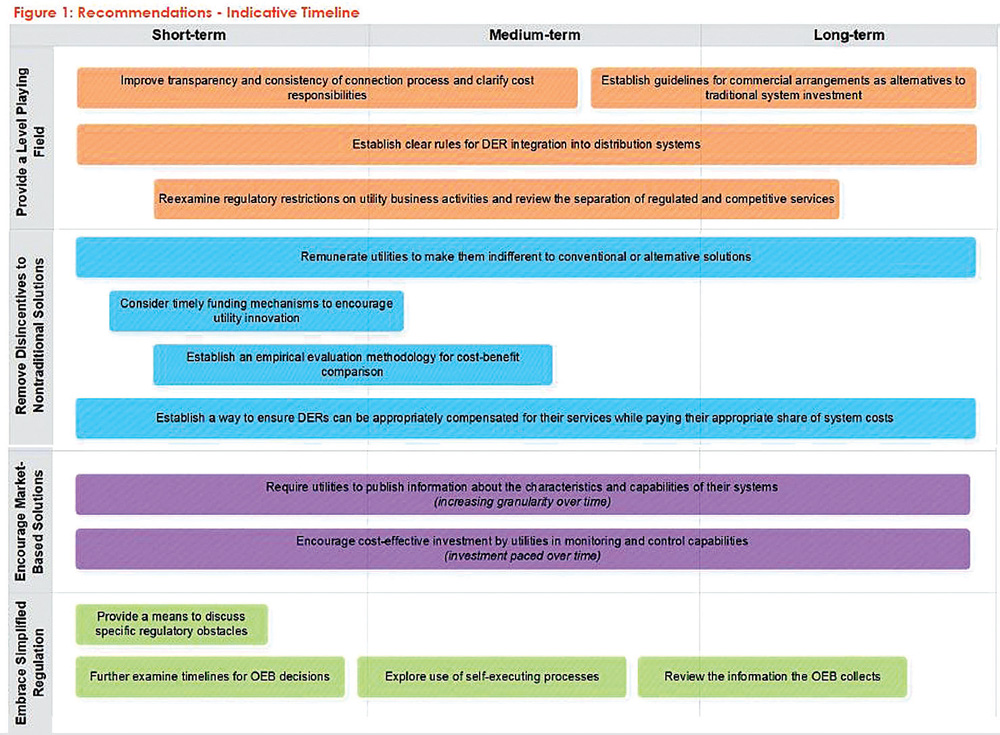On November 22 the Ontario Energy Board released a set of recommendations on how to adapt itself to oversee a very different energy system in the future. The recommendations seem to point squarely in the direction of preparing for growth of DERs and more distributed energy systems. Formally speaking, the recommendations are the final report of the Chair’s Advisory Committee on Innovation. This committee worked in parallel with the government-mandated OEB Modernization Panel review, chaired by Richard Dicerni. The Innovation Committee, chaired by former IESO President and CEO Paul Murphy, brought together a group of experts to advise the OEB on measures to enhance “efficiency, cost effectiveness, innovation and value for electricity customers.” The Committee’s focus was to identify actions to support and enable cost effective innovation, grid modernization, and consumer choice, and to help inform regulatory policy development.

• Enabling market innovations and supporting customer choice by providing more detailed and timely information about system needs and conditions
• Making roles and obligations between distributors and technology proponents clearer and more consistent
• Developing pathways for innovation through simpler and more predictable regulatory processes
• Considering how best to balance utilities’ incentives to consider and select the best value solutions to meet system and customer needs in an evolving marketplace.
Some of the Committee’s recommendations included the following:
1A. Improve the transparency and consistency of the distribution system connection process and clarify cost responsibilities to reduce uncertainty for DER proponents, utilities and consumers
1B. Establish clear rules for DER integration into distribution systems, addressing technical matters including information, visibility, management and control to, among other things, protect the reliable and safe operation of the distribution system, and optimize the planning and management of resources and assets
1C. Establish guidelines for commercial arrangements governing performance of non-traditional resources so utilities and others can rely upon them as alternatives to traditional system investment
1D. Reexamine regulatory restrictions on utility business activities and review the separation of regulated and competitive services in light of new technologies and service expectations
2A. Remunerate utilities to make them indifferent to conventional or alternative solutions, including when other parties own and provide the alternative solution. Considerations will include, among other things, meaningful incentives and moving away from traditional rate base regulation
2B. Establish an empirical evaluation methodology for cost-benefit comparison so all proposals are evaluated on a fair and consistent basis. Elements such as the value of optionality (i.e., the benefit of having options down the road), flexibility, location, time, resiliency, optimizing existing assets, and externalities as appropriate should be considered
2C. Establish a way to ensure DERs can be compensated for their services commensurate with their value while paying their appropriate share of system costs. The approach should recognize new revenue streams that may be aggregated and allow shared cost recovery
2D. Consider timely funding mechanisms to encourage utility innovation that provides near term customer benefits
3A. Require utilities to publish information about the characteristics and capabilities of their systems to enhance transparency of distribution system needs and capabilities within the market
3B. Encourage cost-effective investment by utilities in monitoring and control capabilities to the extent that these enabling investments will help them efficiently manage a more dynamic distribution system
4A. Provide a means by which both utilities and unregulated entities are encouraged to discuss specific regulatory obstacles with the OEB, in order to allow near-term deployment of innovations while longer-term regulatory reforms are implemented.
The OEB is now launching consultations to gain input more broadly from stakeholders. A Stakeholder Forum has been scheduled for January 16th. The full report is available on the OEB website.
The report was designed in part to build on a previous report prepared for the OEB and released about a year ago: “Strategic Blueprint: Keeping Pace with an Evolving Energy Sector.” See also this story “OEB plans to minimize barriers to innovation while protecting consumers,” from IPPSO FACTO January 2018.
